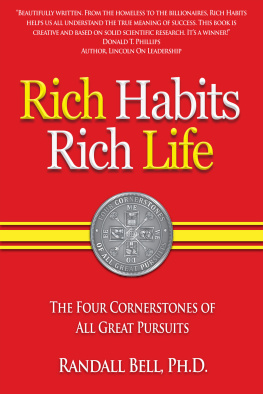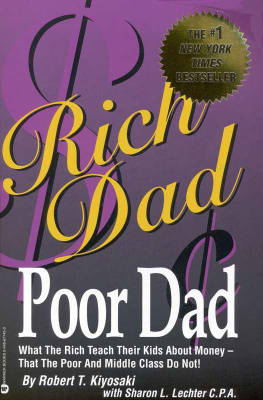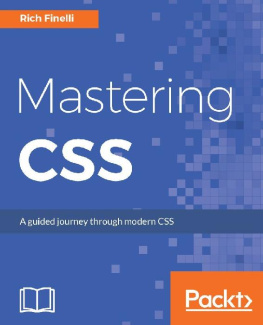Stoute - Help, Im Rich!
Here you can read online Stoute - Help, Im Rich! full text of the book (entire story) in english for free. Download pdf and epub, get meaning, cover and reviews about this ebook. year: 2014, publisher: Wiley, genre: Romance novel. Description of the work, (preface) as well as reviews are available. Best literature library LitArk.com created for fans of good reading and offers a wide selection of genres:
Romance novel
Science fiction
Adventure
Detective
Science
History
Home and family
Prose
Art
Politics
Computer
Non-fiction
Religion
Business
Children
Humor
Choose a favorite category and find really read worthwhile books. Enjoy immersion in the world of imagination, feel the emotions of the characters or learn something new for yourself, make an fascinating discovery.
- Book:Help, Im Rich!
- Author:
- Publisher:Wiley
- Genre:
- Year:2014
- Rating:5 / 5
- Favourites:Add to favourites
- Your mark:
- 100
- 1
- 2
- 3
- 4
- 5
Help, Im Rich!: summary, description and annotation
We offer to read an annotation, description, summary or preface (depends on what the author of the book "Help, Im Rich!" wrote himself). If you haven't found the necessary information about the book — write in the comments, we will try to find it.
Stoute: author's other books
Who wrote Help, Im Rich!? Find out the surname, the name of the author of the book and a list of all author's works by series.
Help, Im Rich! — read online for free the complete book (whole text) full work
Below is the text of the book, divided by pages. System saving the place of the last page read, allows you to conveniently read the book "Help, Im Rich!" online for free, without having to search again every time where you left off. Put a bookmark, and you can go to the page where you finished reading at any time.
Font size:
Interval:
Bookmark:

Cover Design: Wiley
Cover Image: Created by Wiley using elements from iStock.com images
Copyright 2015 by John Wiley & Sons Singapore Pte. Ltd.
Published by John Wiley & Sons Singapore Pte. Ltd.
1 Fusionopolis Walk, #07-01, Solaris South Tower, Singapore 138628
All rights reserved.
No part of this publication may be reproduced, stored in a retrieval system, or transmitted in any form or by any means, electronic, mechanical, photocopying, recording, scanning, or otherwise, except as expressly permitted by law, without either the prior written permission of the Publisher, or authorization through payment of the appropriate photocopy fee to the Copyright Clearance Center. Requests for permission should be addressed to the Publisher, John Wiley & Sons Singapore Pte. Ltd., 1 Fusionopolis Walk, #07-01, Solaris South Tower, Singapore 138628, tel: 6566438000, fax: 6566438008, e-mail: .
Limit of Liability/Disclaimer of Warranty: While the publisher and author have used their best efforts in preparing this book, they make no representations or warranties with respect to the accuracy or completeness of the contents of this book and specifically disclaim any implied warranties of merchantability or fitness for a particular purpose. No warranty may be created or extended by sales representatives or written sales materials. The advice and strategies contained herein may not be suitable for your situation. You should consult with a professional where appropriate. Neither the publisher nor the author shall be liable for any damages arising herefrom.
Other Wiley Editorial Offices
John Wiley & Sons, 111 River Street, Hoboken, NJ 07030, USA
John Wiley & Sons, The Atrium, Southern Gate, Chichester, West Sussex, P019 8SQ, United Kingdom
John Wiley & Sons (Canada) Ltd., 5353 Dundas Street West, Suite 400, Toronto, Ontario, M9B 6HB, Canada
John Wiley & Sons Australia Ltd., 42 McDougall Street, Milton, Queensland 4064, Australia
Wiley-VCH, Boschstrasse 12, D-69469 Weinheim, Germany
Library of Congress Cataloging-in-Publication Data
ISBN 978-1-119-02054-7 (Hardcover)
ISBN 978-1-119-02053-0 (ePDF)
ISBN 978-1-119-02055-4 (ePub)
You don't know who is swimming naked until the tide goes out. The truth of this famous Warren Buffett phrase became painfully clear during and immediately after the financial crisis in 2008. To a large extent, private banking had evolved into a sales industry. To drum up revenue, private bankers were instructed by their managers to sell. Targets and key performance indicators (KPIs) drove the businessnot clients.
As long as the markets went up, nobody questioned this and it did not pose a serious issue. Almost every product seemed to perform well, so who cared whether clients were properly advised?
Then the tide went out. Most of the bankers who had sold the products were nowhere to be found and their clients were left behind.
It appeared that many of the loss-making investments in clients' portfolios should never have been recommended in the first place. The public was incensed. The assumed duty of care was sacrificed for the desire to increase revenue. The verdict: Hang those immoral and greedy bankers out to dry.
This might seem somewhat exaggerated but it was, in a nutshell, the post-crisis sentiment. Apart from the fact that the entire financial system seemed on the verge of collapse, public faith in the integrity of the industry dwindled, reaching a historic low.
That triggered regulators from all over the world into corrective action. The credibility of the financial services industry needed to be restored. The banks had created a mess and now it was up to the regulators to sort things out and make sure that history would never repeat itself. In fairness, most banks took responsibility for what happened and initiated programs to improve the situation. A commitment to increasing quality and integrity levels resulted in myriad new regulations, rules, guidelines, policies, procedures, and so on.
However, the combination of a highly skeptical public and a never-ending stream of new policies, no matter how justifiable, affected morale in the industry.
For any service to be value adding at least two conditions need to be met:
- The service provider must have an unwavering belief in the added value of its own service offering, as demonstrated through a high level of passion.
- The service recipient must have an open, welcoming, and inviting mindset.
When we look at the private banking industry we still fail, generally speaking, to be confident that both conditions are met. That creates a serious impediment toward the development of a truly value-adding industry. It is mainly a shame because this situation deprives high-net-worth individuals (HNWIs) of the support that the industry is capable of offering in managing and organizing their wealth.
Private banks employ many high-level professionals who have what it takes to alleviate the typical wealth-related concerns that trouble the rich. It is often sad to see so much of that talent go to waste due to a lack of faith among clients and lack of motivation among the providers.
It is first and foremost in the best interest of HNWIs that the value-adding potential of the industry gets unlocked. Most rich people need professional help to address specific concerns. Regulators and banks need to continue to work hard to restore trust in the industry. A lot has been done, but a lot more is still required.
However, as outlined by Kees Stoute in this book, the rich also ought to play a constructive role. By increasing their knowledge of what to expect from their private banker, clients not only increase their own level of trust in the industry, but further boost the morale of the true professionals working within it, and thus contribute to the further development of a value-adding private banking industry. As the rich stand to gain the most from this, it would be time well spent to read the insights in this book.
What I particularly like about this book is that it is primarily targeted at private banking clients, even though the ulterior intention is to contribute to increasing the added value of the private banking industry as a whole.
It is difficult to find a better professional than Kees Stoute to produce this book. With over 20 years of experience in the private banking industry, 12 of which as CEO for MeesPierson Asia and EFG Bank in South Asia, respectively, he is an industry veteran. Through his input at the Private Banking Industry Groupa consultative forum that was established by the Monetary Authority of Singapore (MAS)his frequent and active participation in seminars and conferences, as well as his written contributions, Kees has consistently displayed an outspoken and passionate drive to contribute to the improvement of the quality and credibility of the industry as a whole, not just the institutions he has worked for.
In Singapore, Kees also became a strong advocate of the Financial Industry Competency Standards (FICS), which in 2011 led to EFG Bank Singapore attaining the FICS Inspire Special Mention Award at the IBF FICS Annual Conference. Kees himself became one of the first in Singapore to be certified as Financial Industry Certified Professional (FICP Role Model 6).
This dedication gained him an enviable reputation among former colleagues and competitors alike. We were honored to present Kees in 2012 with the inaugural Hubbis Recognition of Excellence in Asian Wealth Management Award.
His mission to contribute to the overall good of the industry has been further invigorated since he founded Sonam, a private banking training and consultancy firm, culminating in this book.
Next pageFont size:
Interval:
Bookmark:
Similar books «Help, Im Rich!»
Look at similar books to Help, Im Rich!. We have selected literature similar in name and meaning in the hope of providing readers with more options to find new, interesting, not yet read works.
Discussion, reviews of the book Help, Im Rich! and just readers' own opinions. Leave your comments, write what you think about the work, its meaning or the main characters. Specify what exactly you liked and what you didn't like, and why you think so.









